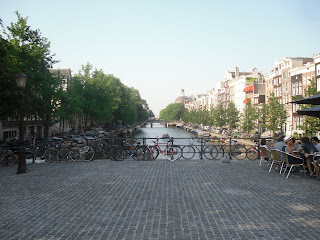When trying to honor their history and establish a sense of national identity, Berliners have one major obstacle. How to remember the two dictatorships of the past century. When concerning the Nazis and the Third Reich, the approach has long been the same. Destroy everything and act as if they never existed.
This approach, however, is quite naive. It is necessary for one to first accept the past in order to overcome it. This is what current generations are finally beginning to realize and slowly filling the void in German history lasting from 1930 until 1945. This task is quite hard as Germans still have a strong fear of the past repeating itself. Any sort of monument or museum directly associated with Nazism could provide a possible rallying point for Neo-Nazis. Therefore, Germans have chosen to commemorate the victims of the Third Reich as well as those who opposed them. This is apparent through numerous Holocaust Memorials, etc ... as well as monuments paying tribute to men like von Staufenberg who attempted to ended Hitler’s reign. This still is not enough. In order too fully understand a crime, one must understand both the victim and their oppressor.
This task is very difficult as most evidence of Nazism was been destroyed shortly after the war and one certainly does not want to rebuild it. I do not necessarily disagrees with the decision to destroy these buildings, especially those directly associated with Hitler, but who is necessarily correct in saying which buildings are Nazi. Is it the building’s style or is it its historical significance. If one desired to go out and destroy every utilitarian building in the city, it would cost a considerable sum and wipe out a large chunk of the city. Instead, people must realize that everything built during the Third Reich was not directly linked to its evils. The few areas that are left that are directly related to the crimes committed should not be destroyed but saved to better understand this point in history. The one location that seemed to realize this was the Topographies of Terror. Historians and archaeologists manage to save a small chunk of the SS headquarters and opened them to the public along with an exhibition explaining the heinous acts committed here. Though it may be difficult for German to confront, things like this will allow them to move on despite this chapter in their history.
The more difficult task of the German people still awaits. How to commemorate the city’s division and the Communist dictatorship. This question is slightly more difficult than that of the Nazis as the Communist can be portrayed as both heroes and criminals. During the Third Reich, the Communists were one of the main opposers to the Nazi Party. Also, the Russian Communists were the first to invade Berlin and widely given credit for defeating the Nazis. If the story ended here, there would no doubtably be Communists statued and memorials littering the city. However, when the Communists seized control of East Germany following the war, things took a turn for the worse. Communists took away most of the citizens rights and are responsible for building the Berlin Wall which completely divided the city. The imprisoned numerous wall jumpers and killed several as well why they tried to escape to the West.
The dictatorship end thankfully in 1990. Now Germans must accept their reunification while still acknowledging their once divided state. Possibly the hardest decision is deciding what remains and monuments on the Communists are worth keeping. Obviously the first monument of Communist rule to come down was the wall itself. Other monuments were not immediately destroyed. Some of the Russian’s monuments built just after the war like Treptower Park were forbidden to be destroyed as they marked the resting place of thousands of Russian soldiers. Other like monuments to Stalin and Marx were subject to great debates. Now most Germans realize that destruction does not free them from their past. Therefore, several monuments like the one to Karl Marx on Karl-Marx Allee were saved and serve as a reminder of past events. The treatment of these monuments show how much the city of Berlin has grown and transcended its dark past.











































